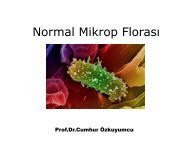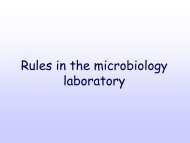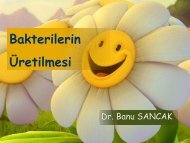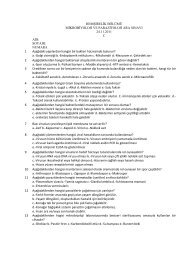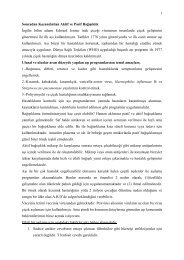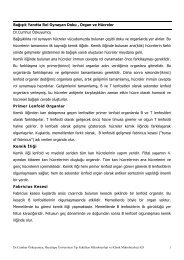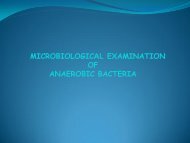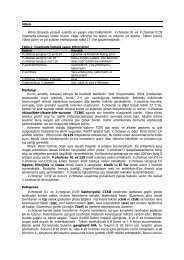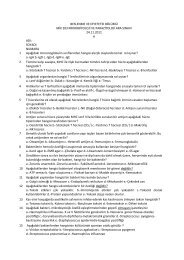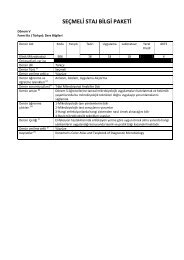NORMAL MICROBIAL FLORA
NORMAL MICROBIAL FLORA
NORMAL MICROBIAL FLORA
You also want an ePaper? Increase the reach of your titles
YUMPU automatically turns print PDFs into web optimized ePapers that Google loves.
water breaks and the birth process begins, so does colonization of the body surfaces.<br />
Handling and feeding of the infant after birth leads to establishment of a stable<br />
normal flora on the skin, oral cavity and intestinal tract in about 48 hours.<br />
Resident flora: Consist of relatively fixed types of microorganisms regularly found in<br />
a given area at a given age. Resident flora promptly reestablishes itself if disturbed.<br />
Transient flora: Consist of non-pathogenic or potentially pathogenic microorganisms<br />
that inhabit the mucous membranes for hours, days, weeks. Members of the transient<br />
flora are derived from the environment and they are not establish themselves<br />
permenantly on the surfaces. They can not cause infectious diseases if resident flora<br />
remains intact.<br />
Normal flora of the skin:<br />
Several factors such as dryness, low pH, inhibitory substances (lysozyme from sweat<br />
glands and toxic fatty acids from sebaceous glands) are responsible for discouraging<br />
skin colonization. Staphylococcus species do compose 90% of aerobic members of<br />
normal skin flora. Anaerobic diphteroids inhabit deeper layers of skin.<br />
Normal flora of respiratory tract:<br />
Mouth: Continous flow of saliva exerts a mechanical flushing action that removes<br />
many microorganisms. Until eruption of teeth, most microorganisms in oral cavity are<br />
aerobes and facultative anaerobes. As the first tooth appears, obligate anaerobes<br />
become more evident as the tissue surrounding the teeth provides an anaerobic<br />
environment. Streptococcus mutans is a member of normal oral flora and appears to<br />
be the major ethiological agent of dental caries.<br />
Upper respiratory tract: Through inhalation, air containing microorganisms pass<br />
through nasal passages and nasopharynx, microorganisms stick to the thin moisty<br />
layer of highly viscous mucus that overlies these surfaces. Mucus also contains<br />
bactericidal enzyme, lysozyme. In additon, rythmic beating of ciliar epithelial cells of<br />
upper respiratory tract drives microorganisms through pharynx. Nose and<br />
nasopharynx are inhabited by many microorganisms despite those mechanisms.<br />
A large number of bacterial species colonize upper respiratory tract (nasopharynx).<br />
Nostrils are always heavily colonized, predominantly with Staphylococcus<br />
epidermidis and Corynebacteria, and often (in about 20% of the general population)<br />
with Staphylococcus aureus, this being the main carrier site of this important<br />
pathogen.<br />
Staphylococci are the main habitants of the nose. Other normal flora members of<br />
nasopharynx are to be Streptococcus, Neisseria and Haemophilus species.<br />
Lower respiratory tract: Trachea and bronchi do not have a normal flora due to ciliadriven<br />
mucus flow. The lower respiratory tract (trachea, bronchi and pulmonary<br />
tissues) is virtually free of microorganisms, mainly because of the efficient cleansing<br />
action of the ciliated epithelium which lines the tract. Any bacteria reaching the lower<br />
2



